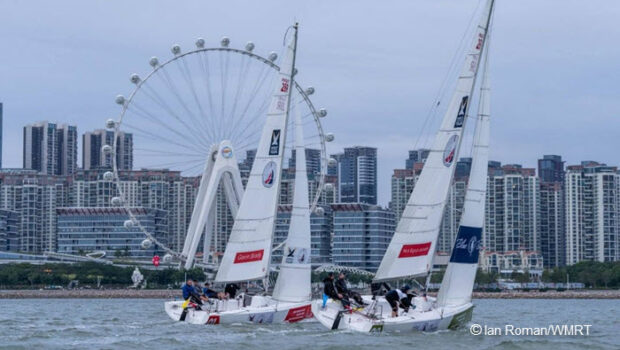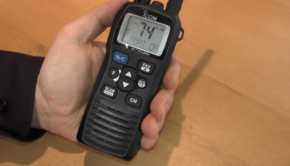Decision-making contest on steroids
Published on January 23rd, 2024
Dave Perry, match racing champion, educator, and editor of the The Dial Up publication, details what he calls ‘The Big Decision’:
I have always said “Sailboat racing is a decision-making contest played in sailboats.” And match racing is a decision-making contest on steroids! It has been my experience that the boat that makes more good decisions, and fewer bad ones, wins.
In this piece, I am going to walk through what I think is one of the Biggest Decisions a tactician must make in a match race. You go off the line just to windward of your opponent. You tack onto port tack and your opponent does the same. You are now engaged in a do-or-die drag race to the right. If you can get up to their line and force them to tack first, you can tack and hold the control in the race. If they can live to the starboard-tack layline, they win the first leg.
Here’s my playbook in this scenario:
1) If I do not think the windward boat can lee-bow or tack clear ahead of me, then I will wait until I am within 1-2 lengths of the starboard-tack layline and tack. That way, if the windward boat tacks to leeward of me, I am in control of the race and will round the windward mark first. And if the windward boat passes astern of me and tacks up on my hip, I will be clear ahead when I reach the zone of the windward mark and can tack onto port tack with the protection of mark-room (rule 18.2) and round ahead. I call this “the starboard layline is my friend.”
Note: if I am the windward boat in this situation, I always tack to leeward of my opponent. That gives me clear air and water for the long starboard tack; and gives me a couple more boat lengths on port tack at the top of the beat to set up for a strong bear away spinnaker set. I call this “minimizing loss.”
2) If I am bow out and I think the windward boat is two or more lengths ahead, then I have to tack well before I get to the layline and try to drag the game back towards the middle of the beat. The reason is obvious. If I tack on the starboard-tack layline and my opponent tacks right on my wind, I will lose many boat lengths by the time the boats get to the windward mark. My goal is to maximize the clear air and water I sail in for the rest of the beat. Again, I call this “minimize loss.”
Once I realize that I will not be ahead of them before I get to the layline, I am looking for the best soonest opportunity to tack. Maybe there’s a little pressure coming down to tack in, or a slight right shift, or a good flat spot in the water, or my opponent just hit a wave badly.
After tacking, the decision goes to the other boat as to when they will tack. Maybe they will cross over and tack to windward and astern of me, giving me clear air and water towards the middle. Great. Once I get to the middle, I am again looking for the best soonest opportunity to tack.
Maybe they will tack on my wind. Great. I wait for their bad air to reach me (the jib will slightly luff) and tack through their disturbed air (giving me a better tack because of the reduced pressure on my rig). I go a “speed build” (about 4 lengths) and tack back. I call that a “speed build & tack.” Again, you do NOT want to get to either layline where the other boat can tack on your wind.
Or maybe they’ll tack in the worst place for them: to windward and ahead of me, in which case I tack as soon as they tack, go a “speed build and tack” back. I will have clear air the entire beat.

At position 3, after W tacks and before she is up to speed, L tacks. That will put the boats “out of phase” with each other for the rest of the beat, which is good for L and bad for W.
3) If I think I will “have a piece of them” when I tack, meaning I could hit them if both boats held their courses, and I don’t think I am gaining on them in time to be ahead of them when I tack, then I am looking for my best soonest opportunity to tack. I come out of my tack “fat” meaning slightly below close-hauled for a fast speed build, and I watch them carefully.
If they lee-bow me (tack tight to leeward of me), then I have to make a QUICK decision. Do I have enough relative speed advantage to be able to do a slight luff to gain separation and then press down to my close-hauled course and pin them to the port-tack layline? Or not, in which case I need to tack out INSTANTLY. If I hesitate and let them build speed and then tack, they can easily tack with me and pin me to the starboard-tack layline. I call this “when in doubt, get out!”
The bigger decision is what to do if the windward boat begins to bear away to duck me. My move depends on how close I am to the starboard-tack layline, and whether I am up to speed when the boats come together. If I am within 6-8 lengths or so of the layline and up to speed, then I do what I call the “Soft Slam Dunk.” I might hunt down 10 degrees or so to force my opponent to bear away a little farther, but I am back up to a close-hauled course when my opponent’s bow is at my transom. This is critical! When my opponent’s bow is at my transom, I count to 2 (“1-2”) and tack. My opponent will either tack immediately and pass astern of me (I am protected by rules 13, 15 and 16.1 when my opponent tacks) in which case I go to the starboard-tack layline (“the starboard-tack layline is my friend”), or they will continue sailing on port tack in which case I can pin them for the 6-8 lengths of sailing to the starboard-tack layline.
If I am more than 8 or so lengths from the starboard-tack layline and up to speed, then the moment my opponent bears away to duck me, I tack to leeward of them. They will either tack away, in which case I go the starboard-tack layline (“the starboard-tack layline is my friend”). Or they will try to live above me, in which case as soon as I am up to speed, I go into an aggressive “high mode” (pinching) and force them to tack, in which case I can tack with them and control the rest of the beat.
One caution is that, with no rule 17 (On the Same Tack; Proper Course) in match racing, a third option for your opponent when you tack to leeward or in front of them is to try to overlap you to leeward, then luff you and force you to tack away. If this works, then your opponent will control the rest of the beat. If it does not work, then your opponent will lose many lengths on you by the time you get to the windward mark. The best protection for you is to tack the moment your opponent begins bearing away. I call that “sooner than later.”













 We’ll keep your information safe.
We’ll keep your information safe.